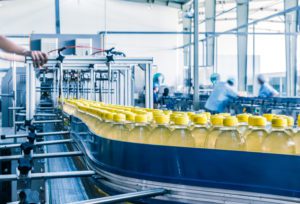How Connected Worker Technology Supports Food Processing Facilities During COVID-19 Crisis
For the past four months, the manufacturing and processing industries have faced significant disruptions to operations and production due to COVID-19. As some facilities that previously closed begin to reopen, they are challenged with how to keep employees safe on the factory floor.
A recent update from IndustryWeek describes the current state of affairs:
In those 11 weeks, entire state economies have been shut down and reopened; factories have closed and reopened, or remained dark; more than 40 million have people applied for unemployment insurance and more than 100,000 people in the United States have died. The situation remains volatile, but notably less so. Manufacturers with little to no information in the early days of the pandemic have established protocols for reducing the spread of the virus, and states have begun to lift pandemic-era quarantine orders.
COVID-19 Spreading Among Food Processing Facilities
Over the past couple of weeks, as new hot spots have emerged, COVID-19 cases have risen among food processing, packaging and meatpacking plants. America’s food suppliers have seen some of the worst outbreaks outside of healthcare. Fruit and vegetable packers, bakers, dairy workers and meat packing plants are at risk of infection as the virus spreads through plants – where employees are essential and sheltering in place is not an option.
As manufacturers try to keep up with the unprecedented consumer demand, many are faced with COVID-19 outbreaks in their factories. And the reactions have varied. Some have shut down plants indefinitely until all workers are tested and the situation is under control. Others have reduced production capacity. Some have temporarily closed to deep clean facilities and rearrange spaces to allow for greater social distancing where possible.
There are around 1.7 million people who work in food and beverage manufacturing facilities, of which roughly 500,000 are at meat processors according to a 2018 U.S. Census Bureau survey. Currently, 11,946 food plant workers have tested positive for COVID-19 and at least 48 have died from it. At least 60 food processing facilities outside the protein industry have seen outbreaks. And 22 food processing factories have temporarily closed to prevent an outbreak on the shop floor, according to Business Insider. There’s still work that needs to be done.
As COVID-19 cases rise among food processing and packaging plant workers, what can manufacturers do to protect their employees? We’re four months into the crisis and manufacturers are still grappling with these troubling times.
With so much uncertainty around the pandemic and its effects on the manufacturing industry, a connected worker solution can help with the challenge of managing plant assets and employees.
The Importance of Technology During the Pandemic
The pandemic has brought two critical considerations to the forefront: employees’ health and safety, and the importance of technology’s role in connecting workers to the right people, information, systems and machines. We are now entering a new phase of manufacturing. The global pandemic has led manufacturers to reexamine how they conduct operations.
Relying on paper-based standard operating procedures (SOPs) in six-inch binders has never been more inadequate. As employees – including management – who can work from home remain off-site, they need a way to reach the frontlines, which are typically deskless workers. How can teams foster collaboration and triage issues, while team members are no longer physically located in the same place?
Connected worker technology digitizes paper-based procedures, ensuring – in real time – that workers are following protocols. They are able to follow SOPs instructions, and capture input information each step along the way – which can be easily measured. Managers are then able to tap into all that human activity data, gathering insights that can lead to better decision making – driving continuous improvement.
Companies can use connected worker technology to conduct employee pre-screening.
There are a number of things a worker can do before they come on site, including logging temperature checks. Employees can also fill out a survey through their mobile device and answer basic questions before they arrive at work.
If an employee tests positive, what do you do? Since you have access to all this data, you can start conducting digital contact tracing. Over the last 14 days who were you in contact with, what was the duration of that contact, where in the site did that contact occur, so if you need to do a deep clean you know where to go without shutting down the entire facility.
Connected Work Can Help Identify and Mediate Issues
As a plant manager or supervisor, you can monitor and track the progress of jobs – all while remote – through Parable’s admin portal. We’ve embedded intuitive business intelligence tools into the platform, and made it easy to create dashboards based on your data in Parsable.
You can raise a digital tag for an equipment failure using Issues, track compliance to standard work activities with job completion data, and get real-time notifications when a Deviation, which is an unexpected event, occurs. When you create templates, which can be your forms, checklists and SOPs, you can configure responses to expected – or unexpected – field entries to help drive standardization or highlight deviations.
For example, if you work at a food processing plant, you know that maintaining a specific temperature is critical for safe production. An increase in temperature could lead to the proliferation of bacteria, and ultimately product waste. With COVID-19, you have the potential for food spoilage and workers getting sick.
Within Connected Worker® by Parsable, you can easily spot deviations and identify when a temperature is out of range or unsafe – which are not only automatically flagged, but trigger notifications to team members who need to know and who need to get involved. Now that the issue is flagged, the appropriate people are notified and the response team can quickly review the details of what happened, when and figure out a plan of action – all while remote. After the team has resolved the issue, the root-cause analysis can be performed and the subsequent corrective actions can be used to improve the standard work instructions — all on a single platform.
Going back to our example, if the temperature on a line in your food processing plant is out of spec, you can:
- Notify the operator who’s on the job to take a series of actions as part of their new updated job. They now have the information sent directly to their mobile device to complete certain steps. This could include making sure part of the machine is turned on properly, checking whether the settings are correct, etc. – in order to stop product from coming into the line from another area.
- Open a work order request into your computerized maintenance management system (CMMS) directly from Parsable so that your maintenance team can triage and follow up – pushed directly back from your CMMS to Parsable. Another job is initiated alerting a maintenance engineer.
Without connected worker technology, you’d be making multiple phone calls, sending emails or even physically going down to the plant to try and figure out what’s going on. The first response for a manager is to go on-site, because there’s no other way to see what the frontline sees with the tools currently in use. But, due to the limitations of COVID-19, you must embrace technology to help monitor what is going on at the factory floor without physically being present.
As manufacturers grapple with these troubling times, connected worker technology empowers those working remotely and on the industry front lines with both the tools and the peace of mind to get their jobs done as safely and efficiently as possible.





